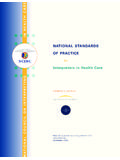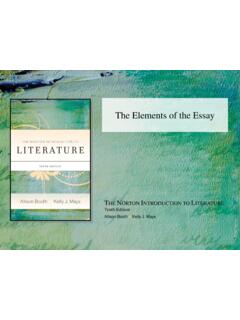Transcription of Qualitative Analysis Techniques for the Review of the ... - ed
1 The Qualitative Report 2012 Volume 17, Article 56, 1-28. Qualitative Analysis Techniques for the Review of the literature Anthony J. Onwuegbuzie Sam Houston State University, Huntsville, TX, USA. Nancy L. Leech University of Colorado Denver, Denver, CO, USA. Kathleen M. T. Collins University of Arkansas at Fayetteville, Fayetteville, AR, USA. In this article, we provide a framework for analyzing and interpreting sources that inform a literature Review or, as it is more aptly called, a research synthesis. Specifically, using Leech and Onwuegbuzie's (2007, 2008) frameworks, we delineate how the following four major source types inform research syntheses: talk, observations, drawings/photographs/videos, and documents.
2 We identify 17 Qualitative data Analysis Techniques that are optimal for analyzing one or more of these source types. Further, we outline the role that the following five Qualitative data Analysis Techniques can play in the research synthesis: constant comparison Analysis , domain Analysis , taxonomic Analysis , componential Analysis , and theme Analysis . We contend that our framework represents a first step in an attempt to help literature reviewers analyze and interpret literature in an optimally rigorous way. Keywords: Review of the literature , Research Synthesis, Qualitative Analysis , Constant Comparison Analysis , Domain Analysis , Taxonomic Analysis , Componential Analysis , Theme Analysis The literature Review represents the most important step of the research process in Qualitative , quantitative, and mixed research studies (Boote & Beile, 2005; Combs, Bustamante, & Onwuegbuzie, 2010; Onwuegbuzie, Collins, Leech, Dellinger, & Jiao, 2010).
3 As noted by Boote and Beile (2005), A thorough, sophisticated literature Review is the foundation and inspiration for substantial, useful research. The complex nature of education research demands such thorough, sophisticated reviews (p. 3). Moreover, Onwuegbuzie et al. (2010) identified 23 benefits that can be derived from conducting a quality Review of the literature , such as the following: distinguish what has been undertaken and what needs to be undertaken, identify variables that are relevant to the topic, identify relationships between theory/concepts and practice, distinguish exemplary research, avoid unintentional and unnecessary replication, identify the main research methodologies and designs that have been utilized, identify contradictions and inconsistencies, and identify strengths and weaknesses of the various research approaches that have been utilized.
4 2 The Qualitative Report 2012. Unfortunately, many research textbooks give the impression that writing a literature Review is no more complicated than writing a high school term paper (Boote &. Beile, 2005, p. 5). According to Fraenkel and Wallen (2006), A literature Review is helpful in two ways. It not only helps researchers glean the ideas of others interested in a particular research question, but it also lets them read about the results of other (similar or related) studies (p. 67). Fraenkel and Wallen (2006) present the following six steps involved in a literature search : 1. Define the research problem as precisely as possible.
5 2. Look at relevant secondary sources. 3. Select and peruse one or two appropriate general reference works. 4. Formulate search terms (key words or phrases) pertinent to the problem or question of interest. 5. Search the general references for relevant primary sources. 6. Obtain and read relevant primary sources, and note and summarize key points in the sources. (p. 68). Yet, these six steps are misleading because the literature Review process represents much more than collecting and summarizing literature . Moreover, the literature Review is a complex process that can be defined as an interpretation of a selection of published and/or unpublished documents available from various sources on a specific topic that optimally involves summarization, Analysis , evaluation, and synthesis of the documents.
6 (Onwuegbuzie et al., 2010, p. 173). Machi and McEvoy (2009) provide another appropriately complex definition of a literature Review , as follows: A literature Review is a written document that presents a logically argued case founded on a comprehensive understanding of the current state of knowledge about a topic of study. This case establishes a convincing thesis to answer the study's question. (p. 4). Despite this complexity, most research methodology textbooks only devote at most one chapter to the literature Review process (Onwuegbuzie & Leech, 2005). Encouragingly, some authors are beginning to acknowledge the complexity of the literature Review process.
7 In an attempt to demystify this process, very recently, these authors have written chapters and books that provide step-by-step guides to conducting literature reviews that begin to capture the critical and interpretive aspects of conducting a comprehensive literature Review (Combs et al., 2010; Dellinger & Leech, 2007; Fink, 2009; Garrard, 2009; Hart, 2005; Leech, Dellinger, Brannagan, & Tanaka, 2010; Machi & McEvoy, 2009; Onwuegbuzie et al., 2010; Ridley, 2008). However, although these sources are useful, none of them provide explicit guidance as to how to formally analyze and interpret selected literature two important components of the literature Review process.
8 We believe that this stems from the fact that the literature Review process has not been considered as a methodological process in its own right. As such, compared to the number of books on research methodology, Qualitative research, statistics, measurement, and the like, as noted by Boote and Beile (2005), there has been a paucity of research and publications devoted to understanding it [what a literature Review is] (p. 5). Anthony J. Onwuegbuzie, Nancy L. Leech, and Kathleen M. T. Collins 3. Although the authors of two methodological works in the area of literature reviews ( , Combs et al., 2010; Onwuegbuzie et al., 2010) incorporate the Analysis and interpretation phases as explicit steps of their literature Review process models, they do not provide details about how to undergo these phases.
9 In fact, a recent comprehensive Review of the literature revealed no article, chapter, or book in which explicit instructions were provided as how to analyze and to interpret selected literature using existing data analytic Techniques . Thus, perhaps, it should not be surprising that a significant proportion of literature reviews in dissertations (Boote & Belie, 2005) and manuscripts submitted to journals for Review for publication (Alton-Lee, 1998; Onwuegbuzie &. Daniel, 2005) are underdeveloped. For example, Alton-Lee (1998), who examined reviewers' comments for 58 manuscripts submitted to Teaching and Teacher Education over a 1-year period ( , 142 reviews), reported that the criticisms associated with the literature Review of these manuscripts were inadequate literature reviews ( ).
10 Theoretical flaws ( ); parochial focus ( ); failure to link findings to the extant literature ( ); and failure to contribute to international literature ( ). In addition, Onwuegbuzie and Daniel (2005), who examined 52 manuscripts submitted to the journal Research in the Schools over a 2-year period, documented that 40% of the submitted manuscripts contained inadequate literature reviews, and that the authors of these manuscripts were more than six times more likely to have their manuscripts rejected for publication than were authors of manuscripts containing adequate literature reviews. As former editor (Educational Researcher), current editor (Research in the Schools), guest editors ( , International Journal of Multiple Research Approaches), and award-winning reviewers for multiple journals, our experience reading hundreds of literature reviews contained in manuscripts submitted to journals over the years has led us to conclude that a major reason for the underdevelopment of literature reviews stems from a lack of formal and systematic Analysis of the extant literature .

















